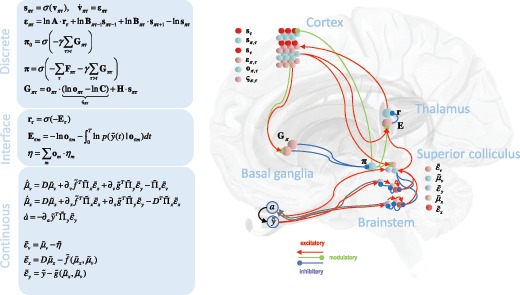Figure 3:

The anatomy of oculomotion. This schematic illustrates the dependencies between the variables in the equations described in the main text and summarized on the left. It does so in the form of a neural network with populations of neurons assigned to plausible anatomical locations. There is a remarkable degree of neuroanatomical plausibility to these assignments, including a common laminar origin for cortical projections to the striatum, superior colliculus, and higher-order thalamic nuclei. In addition, a dual cortico-subcortical input to the colliculus is necessitated by this scheme, as are the excitatory-inhibitory connections of the direct pathway through the basal ganglia. The equations in the box on the top left describe variational message passing in a Markov decision process. The bottom box gives the Bayesian filtering equations of the sort usually associated with predictive coding. The middle box expresses the descending messages derived from Bayesian model averaging and the ascending messages that result from model reduction. We have not shown the neuronal representation of the matrix, encoding preferences. In previous papers, we show that this is likely to be represented in the mapping from higher cortical areas (Friston, Rosch, et al., 2017), such as the dorsolateral prefrontal cortex, an area that houses representations that endure over a longer temporal scale (Parr & Friston, 2017d) and connects to the frontal eye fields.
